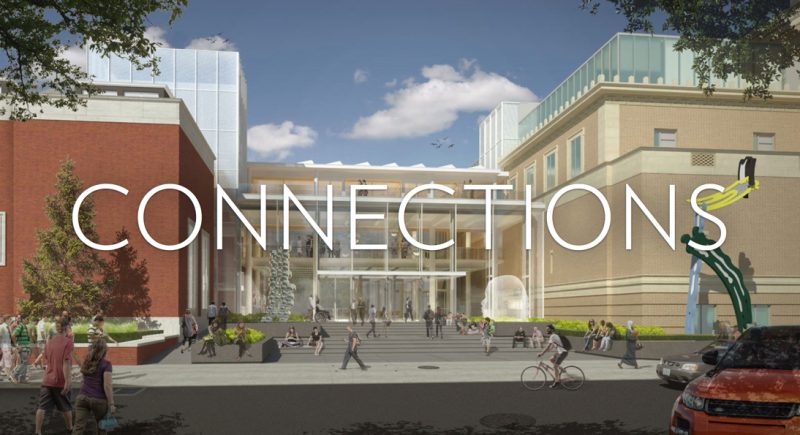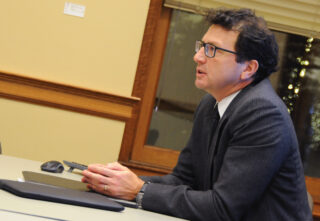
Nearly eight months after their initial request to change a public easement to make room for the new Rothko Pavilion was strongly rebuffed, the Portland Art Museum is trying again.

(Photo: J. Maus/BikePortland)
At the Portland Bicycle Advisory Committee meeting last night in City Hall, PAM’s Executive Director Brian Ferriso struck a conciliatory tone. The BAC (along with the Pedestrian Advisory Committee) formally opposed the initial plans because the new pavilion would enclose the existing Madison Plaza.
Referring to the pushback from the BAC in March, Ferriso opened his comments last night by saying, “I gained a new appreciation for the important work that happens in this room.”
Here’s the background:
SW Madison used to continue through the block that currently houses several museum buildings. When the street was vacated (a.k.a. closed to motor vehicle use) to create a plaza, the public maintained the right to pass between these building due to an easement that’s been on the books since 1968. That initial easement allowed public passage 24 hours a day and required a minimum path width of eight feet (actual width is more like 10-12 feet wide). In 1984 the museum requested — and was granted — permission to close the plaza at night due to security and vandalism concerns.

(Graphic: BikePortland)
“I think ultimately for us, it’s about a big investment in the cultural and educational life of our city core.”
— Brian Ferriso, Portland Art Museum
In order to build their new Rothko Pavilion — which they’ve already raised about $50 million for — PAM wants to enclose a portion of the plaza with a structure to connect the two buildings and create a new main entrance. They need city council to approve a change to the existing easement. The sticking point for people concerned about connectivity (many of whom use the plaza to walk and bike between SW 10th and the Park Blocks), was that — while it would be free to enter the new enclosure — the museum’s initial request would have limited access to the plaza to museum hours of 10:00 am to 5:00 pm Sunday through Wednesday and 10:00 to 8:00 pm Thursday and Friday. Another controversial part of the initial request was that bicycle access (and dogs) would be prohibited.
Beause of considerable opposition from the community back in April, city council shelved the proposal.
Last night Ferriso shared a new proposition: Bicycles and pets will be welcome through the new pavilion from 7:00 am to 11:00 pm every day of the week. This is a significant expansion of hours and access.
However, much to the committee’s chagrin last night, Ferriso shared no new visuals of the design and offered no details about how people would get through the new enclosure. A big concern is that having an enclosed structure across what’s now an open plaza will discourage public access, further erode the street grid, and reduce connectivity of the biking and walking network.
Ferriso told the commmittee the tradeoff is well worth it. “I think ultimately for us, it’s about a big investment in the cultural and educational life of our city core.” The new pavilion would also vastly improve accessibility for museum-goers with its new ground-floor plan. “It’s currently a very difficult campus to navigate,” Ferriso added, “Our overall vision is to make it much more accessible and make sure barriers are taken down for the community.”
Advertisement

Committee members were supportive of the museum’s vision and appreciative of the increase access; but they remain concerned about the lack of detail and specifics about how exactly people on foot and bike would pass through.
“If this is a door, that’s not going to work.”
— Chris Achterman, BAC member
“You’re going to have a very diverse population trying to access it; people on bikes, people in wheelchairs,” BAC member Chris Achterman said. “So if this is a door, that’s not going to work.” Achterman referred to the design of Amsterdam’s Rijksmuseum which has a bikeway that bisects the building (I called it one of the wonders of the bicycle world after a 2013 visit). “I hope that as you approach this project you see it as Portland’s version of the Rijksmuseum.”
“That’s a point well-taken,” Ferriso replied.
“I think further clarification is needed before I can provide an opinion.”
— Roger Averbeck, BAC member
BAC member Roger Averbeck also wondered about how the access would work. “If someone comes through on a bike, can they ride their bike through? Or do they have to get off and walk?” he asked. “What about if they’re on a skateboard?” “That’s a good question,” Ferriso replied. “If you said it’d be important to ride through, we’d take that as feedback.”
“If somebody has to stop, open a door, then open another door,” Averbeck continued, “It doesn’t seem like a place that somebody’s going to be simply traveling through to get from point-a to point-b using a variety of devices including shoes and bikes and wheels and who knows what else. I think further clarification is needed before I can provide an opinion.”
Ferriso acknowledged the lack of fine-grain design details. The current conceptual drawings they have now were done to entice donors and were not meant to be detailed engineering documents.
“All our questions revolve around a design, and you’re not showing a design.”
— Eliot Akwai-Scott, BAC vice-chair
And that’s the rub: The BAC and others are concerned about how exactly the doors or passageway would work, but PAM is saying they can’t answer that question yet. City council isn’t signing off on a detailed design at this point, the only thing technically up for debate is a change to the easement that would allow PAM to move forward and build an enclosed structure. The design of that structure is something that would go through a public process with the Landmarks Commission.
BAC member Keith Liden expressed discomfort with this situation. “We’re being asked to sign off on hours of operation, but we haven’t seen the design yet. We still don’t know what we’re getting. That’s my concern.”
“All our questions revolve around a design, and you’re not showing a design,” added BAC vice-chair Elliot Akwai-Scott. “Given that, you already presented this to council earlier and it sounds like the proposal is more or less unchanged other than an agreement to open the doors [to bicycle users and for longer hours]. What’s the urgency for brining it back to council now, instead of waiting for designs to change and incorporate feedback?”
Ferriso replied that in order to continue fundraising, he needs the basic concept approved before they can move forward to the next phase of design.
In one of the last comments of the night, BAC member Jocelyn Gaudi encouraged the museum to, “Be creative and be humble that this was a former right of way… I love interacting with art when I ride. This is a unique opportunity for that.”
The BAC didn’t take a vote on the issue last night. The museum’s ordinance is on the council agenda for December 7th at 2:00 pm. See a FAQ and learn more about the Rothko Pavilion at PortlandArtMuseum.org.
— Jonathan Maus: (503) 706-8804, @jonathan_maus on Twitter and jonathan@bikeportland.org
Never miss a story. Sign-up for the daily BP Headlines email.
BikePortland needs your support.

